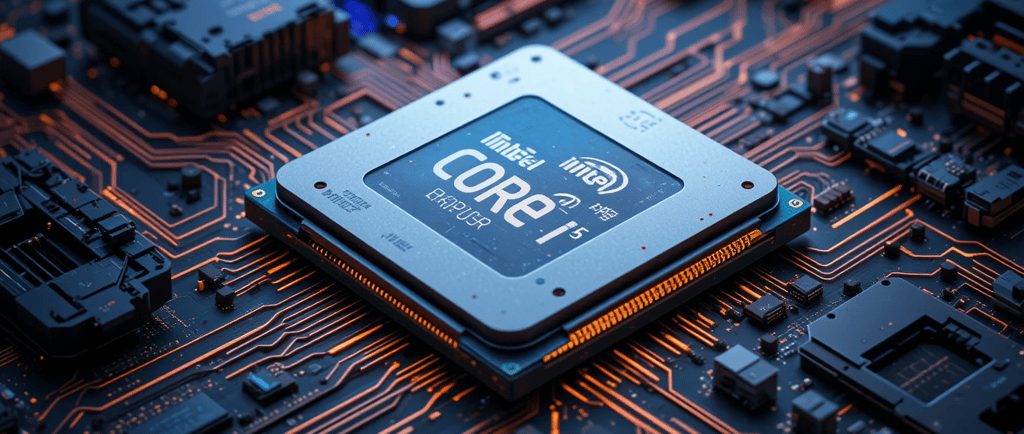Intel Core i5 Raptor Lake Series: Power and Performance in the World of Processing
The Intel Core i5 Raptor Lake series offers powerful performance for gaming, content creation, and productivity, with hybrid architecture, high-speed frequencies, and efficient cores—perfect for modern computing needs.
2/16/20253 min read


Intel Core i5 Raptor Lake Series: Power and Performance in the World of Processing
Welcome to This Processor Series
In a world where technology moves at lightning speed, we use computers daily without often thinking about what makes them work. Processors, small yet powerful, are the brains behind every task our devices perform. Understanding their technical aspects helps us make smarter choices when buying, upgrading, or simply appreciating modern technology.
This article is the first in a series where we’ll explore the fascinating world of processors. We’ll break down core concepts like cores, threads, cache, and frequencies, while also analyzing specific models. Today, we’ll focus on the Intel Core i5 Raptor Lake family, a versatile option for users seeking a balance between performance and affordability. Let’s get started by reviewing some fundamental concepts that will help us better understand these processors.
General Concepts About Processors
To grasp modern processors' performance, it's essential to understand some key concepts:
Cores and Threads:
Imagine a processor as an office with several employees (cores). Each employee can handle a task (thread). The more employees you have, the more tasks you can manage simultaneously.
Modern processors like the Intel Core i5-13600K have 14 cores and 20 threads, efficiently distributing workloads thanks to their hybrid architecture:
Performance Cores (P-Cores): The senior employees, capable of handling two tasks each. They’re ideal for demanding applications like video editing or gaming.
Efficient Cores (E-Cores): The junior employees, responsible for simpler tasks like background processes or browsing.
Base Frequency and Turbo Frequency:
Base frequency is like the regular working pace in the office. Turbo frequency kicks in when there’s extra work, temporarily boosting speed for resource-intensive tasks without overheating the processor.
L3 Cache:
Think of the L3 cache as a small, fast-access shelf beside your desk, holding the most frequently used documents. A larger cache means less time retrieving data from slower storage sources like RAM or the hard drive.
TDP (Thermal Design Power):
TDP measures how much energy a processor consumes under typical usage. A higher TDP suggests more performance potential but also requires better cooling to dissipate heat.
Practical Examples:
Gaming: A high-end game needs turbo frequency and powerful P-Cores to handle complex calculations and visuals.
Video Editing: Editing software like Adobe Premiere uses multiple threads, so having many cores ensures faster video rendering.
Smart Design:
The Raptor Lake processors use a hybrid architecture with two core types:
Performance Cores (P-Cores): For demanding tasks like gaming and video editing.
Efficient Cores (E-Cores): For lighter tasks like browsing or background applications.
Compatibility:
They use the LGA1700 socket, compatible with Intel 600 and 700 series motherboards. The processors also support both DDR4 and DDR5 RAM, giving users flexibility for future upgrades.
Performance Comparison
Against Alder Lake:
The Raptor Lake series delivers a significant performance boost over its predecessor, thanks to more E-Cores and higher turbo frequencies. For example, the i5-13600K has 40% more threads than the i5-12600K, resulting in better multitasking and heavy application performance.
Against AMD Ryzen:
AMD is well-known for its energy-efficient processors, while Intel often leads in raw performance for gaming and heavy workloads. In this case, the i5-13600K outperforms the Ryzen 5 7600X in gaming and multithreaded workloads due to its higher core count, despite AMD's better energy efficiency.
Benchmark Insights:
Up to 15% higher performance in games optimized for multiple threads.
10%-20% faster in video editing tasks compared to AMD's Ryzen 5 7600X, depending on the software.
Energy Consumption and Cooling
Raptor Lake processors consume more power than previous generations and AMD competitors.
The i5-13600K has a base TDP of 125 W, which can spike to 181 W under heavy workloads.
Efficient cooling is crucial to maintain stable performance and extend the lifespan of the processor.
Ideal Use Cases
Gaming Enthusiasts:
High turbo frequencies and support for PCIe Gen 5 make these processors perfect for AAA titles.Content Creators:
With up to 20 threads, they handle video editing, 3D rendering, and live streaming efficiently.Everyday Productivity:
Whether you're working with spreadsheets or multitasking across several applications, Raptor Lake processors provide seamless performance.
Fun Fact
The first Intel processor, the Intel 4004 (1971), had only 2,300 transistors and operated at 740 kHz. Today, the Core i5-13600K has 20 billion transistors and speeds thousands of times faster!
Conclusion
Understanding the core components of our devices, like processors, helps us make better technology choices. The Intel Core i5 Raptor Lake series showcases how mid-range processors can deliver high performance while remaining affordable.
Through this series, we’ll continue to demystify processor technology, covering not only the latest models but also the fundamental principles behind them. Knowing these basics will help you choose the right processor for your needs and appreciate the innovation that powers our daily tasks.
The Core i5 Raptor Lake stands out for its strong performance in gaming, content creation, and productivity. If you’re looking for a reliable, powerful, and future-proof processor, the Core i5-13600K is an excellent choice.
Got any questions or want to learn more about a specific processor? Write to our contact! This series is designed for everyone to learn together, so stay tuned for the next article.
